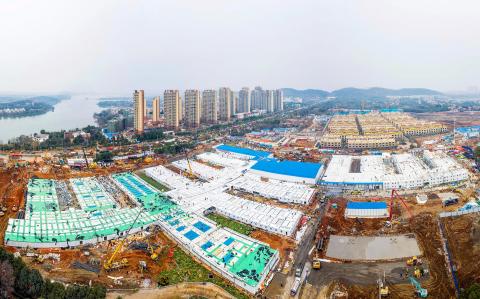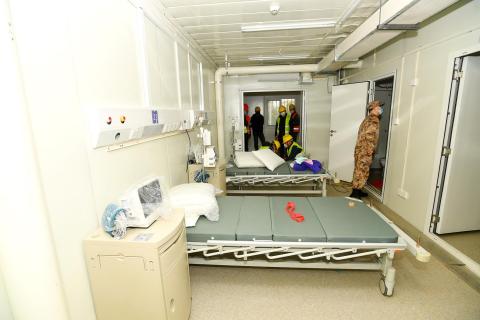Coronavirus patients arrived yesterday at a Chinese field hospital built from scratch in under two weeks at the frontline of the outbreak, state media said, following a round-the-clock construction marathon that became a national social media sensation.
The 1,000-bed facility was built to relieve hospitals swamped with patients in Wuhan, the city in Hubei province at the epicentre of the national health emergency that has killed more in China than the 2003 SARS outbreak.
Fifty patients arrived at the military-run facility, the state-backed China Daily reported, with images showing workers in protective suits pushing people in wheelchairs up a ramp and into the pre-fabricated structure.

Photo: Chinatopix via AP
The virus has killed more than 400 people and infected a further 20,000, nearly all of them in Hubei, and spread to two-dozen countries since it emerged in December at a market that sold wild animals in the city.
The WHO has declared the crisis a global health emergency, and the first death outside China was confirmed in the Philippines on Sunday. As reports surfaced of bed shortages in hospitals in Wuhan, construction began on Huoshenshan (火神山) — “Fire God Mountain” — on Jan. 24. Workers toiled day and night amid a forest of earthmovers and trucks carting materials around the site, southwest of the centre of the city of 11 million.
On the side of one of the trucks, the isolated city’s new rallying cry — “Let’s go Wuhan!” (武漢加油) — was written on a banner.

Photo: EPA-EFE
FIRE AND THUNDER
All workers wore masks, as mandated by the authorities for the entire population of Wuhan, and were checked for fevers during their breaks.
By the following Friday, they had laid 400 prefabricated shipping-container-like rooms, after setting concrete foundations and routing the power supply to the complex.
The two-floor facility was handed over to the army on Sunday and will be staffed with 1,400 military medics, including some with experience dealing with SARS and Ebola.
State media had initially reported that patients would begin arriving Monday — inside the 10-day timeframe authorities had set out when construction began.
Leishenshan (雷神山, Thunder God Mountain), another hospital on an adjacent site, is set to start admitting patients on Thursday, with 1,600 beds.
Fire and thunder are traditionally associated in China with protection against illnesses.
Authorities said the Wuhan facilities were modelled on the Xiaotangshan hospital in Beijing, which was built from prefabricated structures in barely a week to treat patients infected by SARS in 2003. That pathogen killed 349 people in China and hundreds more in Hong Kong and abroad.
However, with the death toll surging in Wuhan and elsewhere in Hubei province, it was not immediately clear what overall impact the hospitals would have on the virus spreading elsewhere.
The city also plans to convert three existing venues, including a gymnasium and an exhibition centre, into hospitals, the Wuhan government said.
The three buildings will be turned into healthcare facilities with a total of 3,400 beds to take in patients with mild symptoms.
LIVESTREAMED
Footage of the mammoth construction effort was livestreamed continuously on social media and watched tens of millions of times.
It has also been feted endlessly in state media as an example of the decisive response to the public health crisis after authorities in Hubei faced a torrent of public anger for perceived incompetence, including delays in announcing the public health emergency.
Local Communist Party secretary Ma Guoqiang (馬國強) acknowledged Friday that officials had worsened the spread of the virus by failing to restrict travel earlier.
When a lockdown and blanket travel ban were finally introduced, they swept up more than 50 million people in Wuhan and nearby cities.

June 23 to June 29 After capturing the walled city of Hsinchu on June 22, 1895, the Japanese hoped to quickly push south and seize control of Taiwan’s entire west coast — but their advance was stalled for more than a month. Not only did local Hakka fighters continue to cause them headaches, resistance forces even attempted to retake the city three times. “We had planned to occupy Anping (Tainan) and Takao (Kaohsiung) as soon as possible, but ever since we took Hsinchu, nearby bandits proclaiming to be ‘righteous people’ (義民) have been destroying train tracks and electrical cables, and gathering in villages

Dr. Y. Tony Yang, Associate Dean of Health Policy and Population Science at George Washington University, argued last week in a piece for the Taipei Times about former president Ma Ying-jeou (馬英九) leading a student delegation to the People’s Republic of China (PRC) that, “The real question is not whether Ma’s visit helps or hurts Taiwan — it is why Taiwan lacks a sophisticated, multi-track approach to one of the most complex geopolitical relationships in the world” (“Ma’s Visit, DPP’s Blind Spot,” June 18, page 8). Yang contends that the Democratic Progressive Party (DPP) has a blind spot: “By treating any

Swooping low over the banks of a Nile River tributary, an aid flight run by retired American military officers released a stream of food-stuffed sacks over a town emptied by fighting in South Sudan, a country wracked by conflict. Last week’s air drop was the latest in a controversial development — private contracting firms led by former US intelligence officers and military veterans delivering aid to some of the world’s deadliest conflict zones, in operations organized with governments that are combatants in the conflicts. The moves are roiling the global aid community, which warns of a more militarized, politicized and profit-seeking trend

This year will go down in the history books. Taiwan faces enormous turmoil and uncertainty in the coming months. Which political parties are in a good position to handle big changes? All of the main parties are beset with challenges. Taking stock, this column examined the Taiwan People’s Party (TPP) (“Huang Kuo-chang’s choking the life out of the TPP,” May 28, page 12), the Democratic Progressive Party (DPP) (“Challenges amid choppy waters for the DPP,” June 14, page 12) and the Chinese Nationalist Party (KMT) (“KMT struggles to seize opportunities as ‘interesting times’ loom,” June 20, page 11). Times like these can